It’s not just grown-up Jane and Michael Banks who need Mary Poppins. A spoonful of her special brand of sugar is just what the world needs now as well. And thanks to director Rob Marshall and company, that’s exactly what we get with MARY POPPINS RETURNS. Practically perfect in every way, you swoop, you soar, you fly high as a kite – or a balloon – as you go down the drain and into the sea and then trip the light fantastic around London with a bunch of leeries. And while we may not jump into a sidewalk chalk drawing, jumping into a spinning Royal Doulton bowl is just as fun and exciting! Then toss in our old friends the 2D animated penguins from 1964 and Dick Van Dyke (who steals the film) and it’s a jolly holiday with MARY POPPINS RETURNS filled with all the wide-eyed wonder and glee imaginable!

Jane and Michael Banks are now all grown up and facing the world on their own. Their parents are long gone. Jane has followed in her mother’s footsteps and is an activist. Michael works at the same bank as his father had, which is now owned by Mr. Dawes, Jr. Sadly, Michael’s wife has passed away and he has been rearing his three children on his own for the past year. Unfortunately, he has let things fall by the wayside, including paying the mortgage on the Banks family home in which he still lives. His sister Jane has stepped in to lend a hand, but there’s only so much that she can do, especially when an eviction notice gets posted on the door. But life for the Bankses is about to change with the wind and the arrival of Mary Poppins.

Scribe David Magee continually references back to the tried and true “Poppisms” that will spark a smile from the older generation and often bring a giggle to the younger – particularly when you watch Emily Blunt’s face as she says certain things. Blunt’s facial expressiveness adds its own element of fun to the proceedings. But most endearing about Magee’s craftsmanship is how he moves the story of Mary Poppins and the Banks children forward, incorporating much from the other seven volumes of P.L. Travers’ beloved books to create new adventures while retaining values of the day – having children follow in their parents’ footsteps, holding on to the family home. But where Magee digs deeper beyond the financial situation of the Banks family is that we see and feel the actual reality of losing one’s home while learning the meaning of what truly is valuable, friends, family and even a bowl. While some may say the story focuses on Michael Banks, I beg to differ. While Michael’s woes may be the catalyst, it is really his children and their efforts and through their eyes that we see the story. The children and Mary Poppins are our POV.
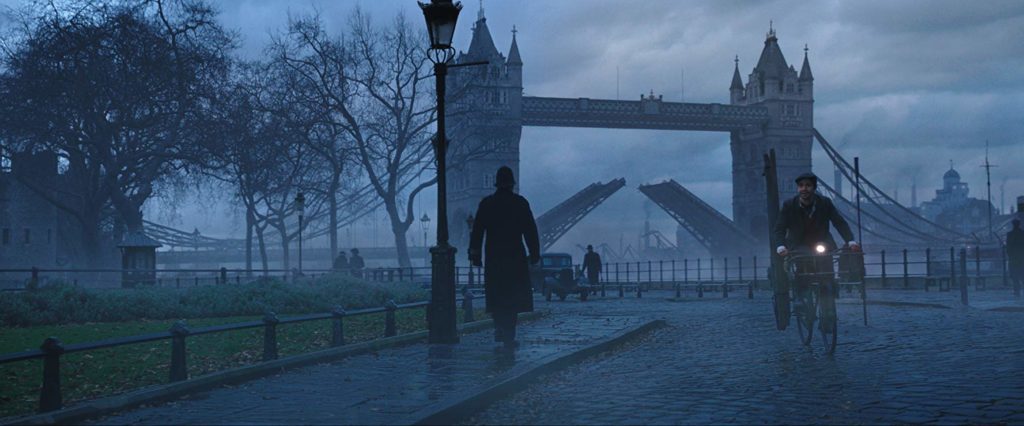
Thanks to Marshall and his animators led by lead character designer James Woods, as much as we are swept away into the kaleidoscopic animated wonder of The Royal Doulton Musical Hall, we are equally taken even deeper into the metaphoric darkness with the animated wolves. While that portion of the animated segment may be a bit too scary for very young children, it also packs a powerful punch of understanding for elementary age kids and older as to what foreclosure is and the toll money woes can take on parents. Magee and Marshall then keenly bring all back into the light and out of the fog reminding everyone that we all have nowhere to go but up.
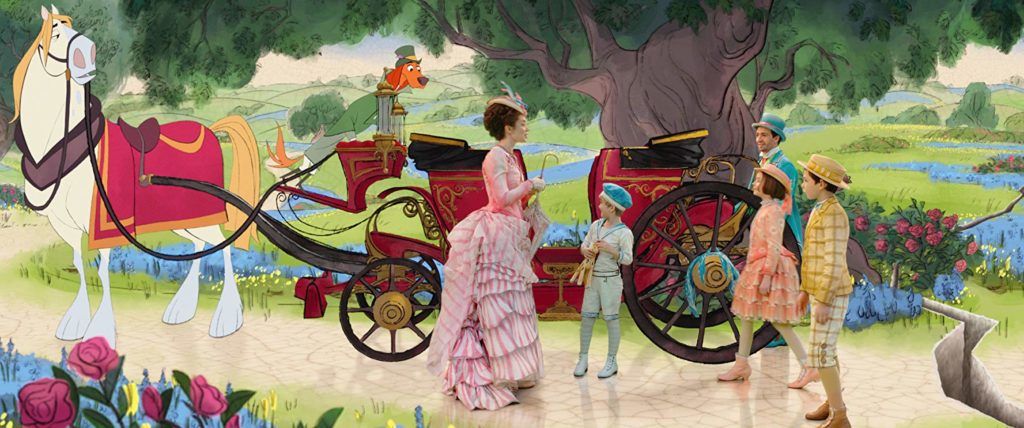
In many respects, director Rob Marshall stays true to the paint-by-numbers formula of the original film which older audiences will undoubtedly appreciate while reinforcing the messaging of the 1964 version for today’s audiences, encouraging each of us to find the child inside and the joy/imagination/hope of childhood again. That touchstone to a kinder, gentler and happier past is so needed today. It’s almost as if FDR is back in the Presidency; the world is in shambles and depressed, and Hollywood is again given an Executive Order to make “happy movies” to take the public’s troubles off the bad things happening in the world. (In this case, however, the executive is Disney’s Bob Iger as opposed to the President of the United States.) Noteworthy is the balance that Marshall and company find with touchstones and paying homage to the 1964 film but proportionately melding them with the current story of MARY POPPINS RETURNS. Marshall doesn’t rely on the past to carry the film and thanks to vibrant performances and musical numbers sets his own standard of storytelling excellence. Staying true to the Golden Age movie musicals of the 50’s (and Broadway), song lyrics are integral to the story by way of individual character development, emotional beats and progressing the film forward.
ROB MARSHALL TALKS ABOUT FINDING THE BALANCE OF BLENDING TOUCHSTONES TO “MARY POPPINS” INTO MARY POPPINS RETURNS
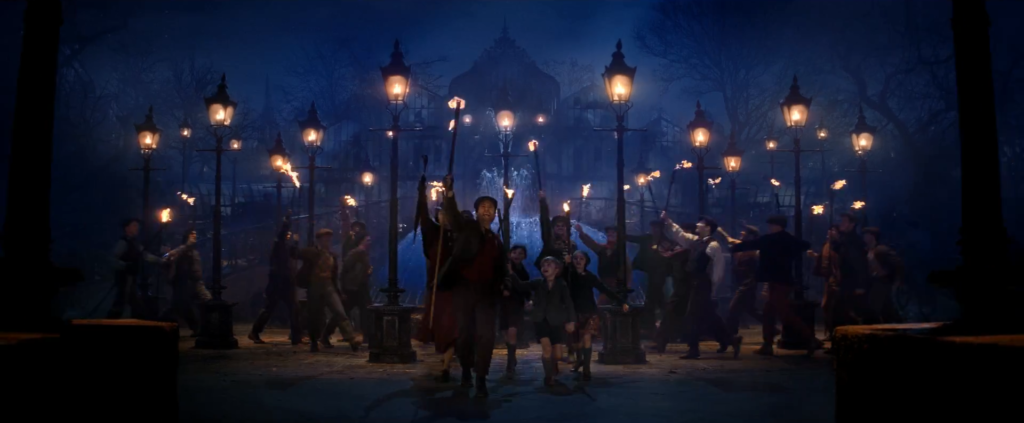
Speaking of songs, while entertaining and engaging in their own right, the nine new songs from Marc Shaiman and Scott Whitman lack some of the zip, zing, and singability of those from the Sherman Brothers in the original “Mary Poppins”. The best and catchiest song in MARY POPPINS RETURNS is “Trip A Little Light Fantastic” which is THE big showstopping song and dance number, much like “Step In Time” in the original film. Thanks to incredible choreography and all-encompassing production design by John Myhre, young and old alike are going to love it. I can’t encourage you enough to actually watch the details of this performance piece, be it the production design or the choreography as each is magnificent. Don’t be surprised to see kids performing the number as little lamplighters in school plays this spring. “Can You Imagine That” is another winner; an easy tune to croon an accompanied by an eye-popping fun-filled underwater sequence. Classic film fans may be particularly in tune with “Nowhere To Go But Up”. Enchanting lyrics and melody and a delightful performance by Angela Lansbury’s “Balloon Lady”, it is in some ways reminiscent of “Up In A Balloon, Boys” which Lansbury she sang in “Gaslight” back in 1944.

It’s easy to see the musical parallels between the original “Mary Poppins” and its songs with that Shaiman and Whitman are delivering here – “Nowhere to Go But Up” is the new “Let’s Go Fly A Kite”, “Trip A Little Light Fantastic” is the new “Step In Time”, “Turning Turtle” is the new “I Love to Laugh” (but be forewarned, Meryl Streep as Topsy doesn’t even come close to comparing with Ed Wynn as Uncle Albert in that number. Streep and Topsy just don’t feel like they fit with this film), “A Cover Is Not the Book” is the animated equivalent to “Jolly Holiday”, etc. Most appreciated are the wonderful instrumental phrasings of all the original songs from 1964 which are interwoven within the score of MARY POPPINS RETURNS.
Choreography of the musical numbers, especially “Trip A Little Light Fantastic”, is nothing short of supercalifragilisticexpialidocious.

Emily Blunt so embodies Mary Poppins that one quickly forgets it’s not Julie Andrews on the screen. And although missing the lilt of Andrews’ four-octave soprano, Emily Blunt is no musical slouch and blows you away with “The Royal Doulton Music Hall” stage performance as well as the “Can You Imagine That” bathtub under-the-sea segments. The transition from Andrews to Blunt is seamless as Blunt incorporates the spit spot mannerisms and perfect posture and comportment Andrews brought to the character, giving us that tacit touchstone to the past, yet adds some lovely facial expressiveness and attitude with her eyes and the tiniest upturned smile that makes you feel like she’s almost winking to you in the audience. And her song and dance performance skills are superb.
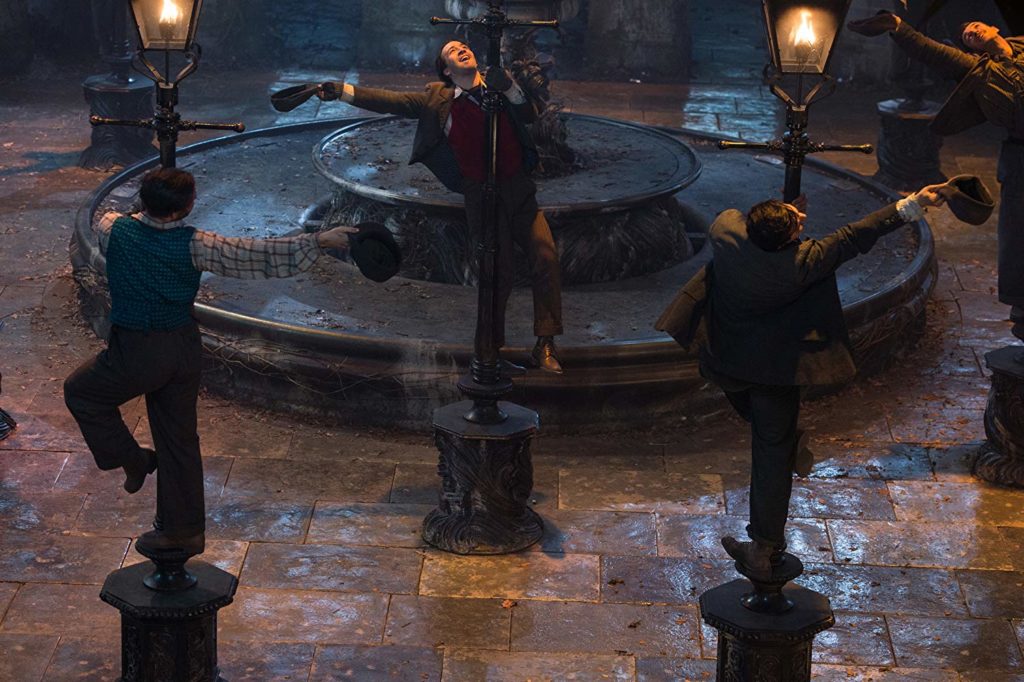
Lin-Manuel Miranda is happiness personified as Mary’s friend, Jack the Lamplighter. (Here’s your history lesson: Lamplighters are called “leeries”. As far back as the 1800’s, their job was – and to this day still is for the remaining 1500 gas lamplights – to spark the lamps each night and clean and maintain them in the day.) Notable is the tie-in that Jack was an apprentice chimney sweep to Bert back in the original film and while Bert went out to trip the light fantastic around the world, Jack stayed in London lighting the way on Cherry Tree Lane. Nice little romantic touch between Jack and Jane as well which adds an extra bit of charm and sweetness, especially when we get to the third act pastel park scene. Miranda’s athleticism and fluidity are perfect for his dance numbers and when he is dancing, you can’t take your eyes from him. And his mastery of a Cockney accent and “leery speak” is superb.
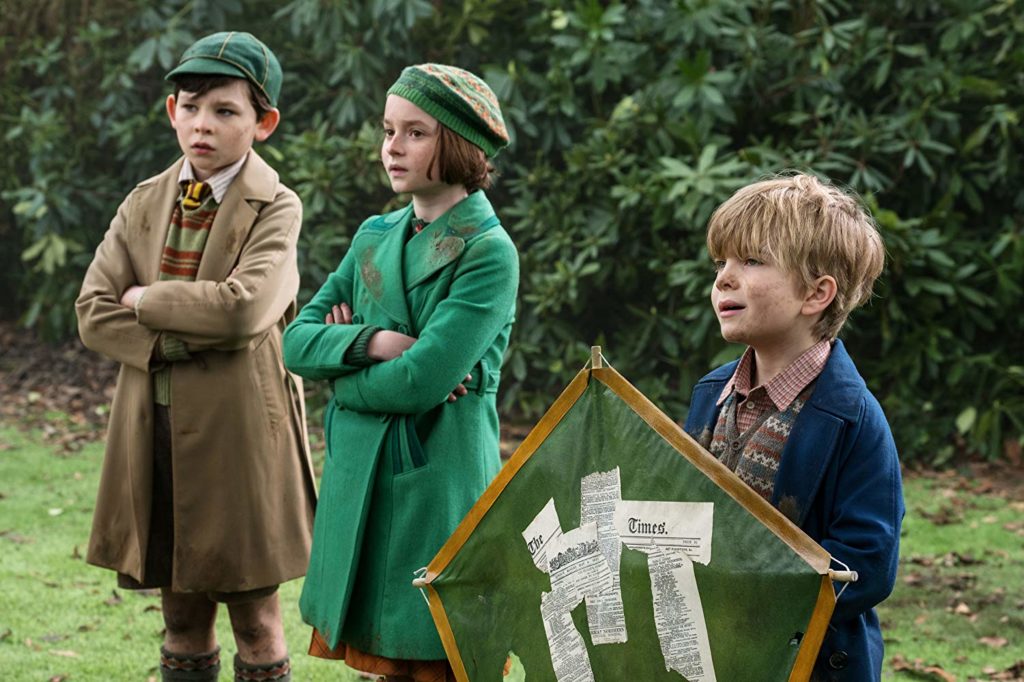
Emily Mortimer’s exuberance as Jane equals that of Miranda’s Jack and is most enjoyable. Ben Whishaw, however, while a perfect gloomy Gus as Michael Banks, becomes a point of annoyance by the third act. Rounding out the Banks family as Michael’s children are Joel Dawson, Pixie Davies, and Nathanael Saleh as Georgie, Anabel and John, respectively. Dawson is the breakout child star here. He is fabulous. Casting, however, deserves kudos for bringing in not only Dawson, but Davies and Saleh, as we are graced with three distinct personalities and the way the characters are written and crafted, it’s the individuality and individual strengths of each which when put together make them very wise and very formidable.
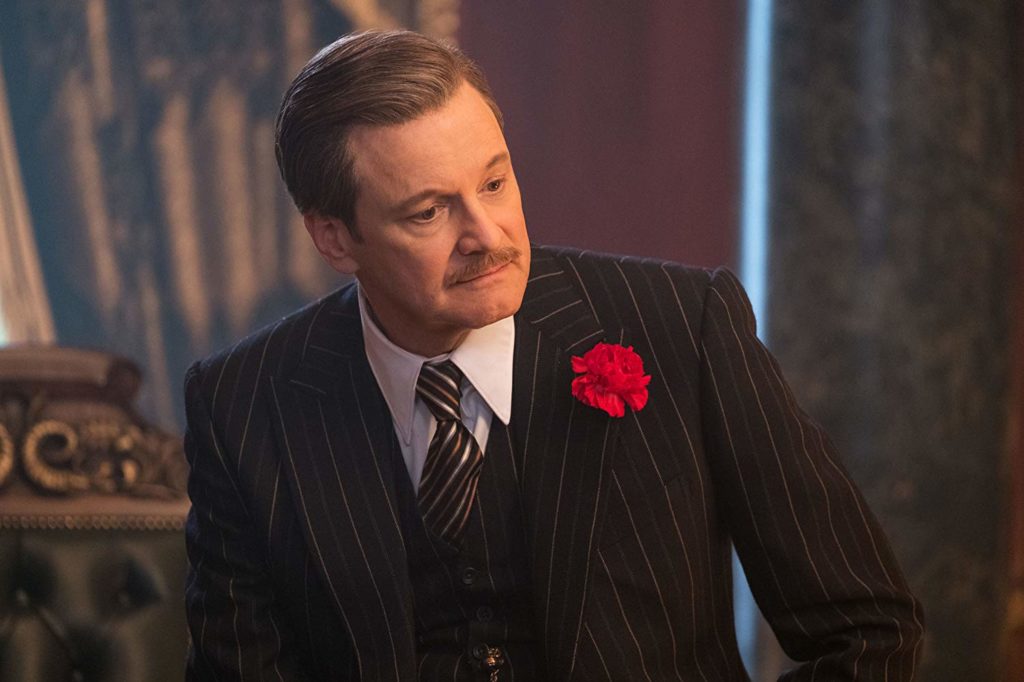
Not to be overlooked is Colin Firth as both bank manager Wilkins and voice of the wolf in the 2D animated sequence. Firth as a bad guy is a rarity but here he does it with such suavity. A true wolf in sheep’s bespoke pinstriped clothing. As mentioned, Meryl Streep steps in as Mary Poppins’ second cousin Topsy. Appearing in one scene only, a musical at that, while the performance is excellent, it feels out of place within the film as a whole.

And then there’s Dick Van Dyke. And a return of 1964’s animated penguins. Pure magic! A sidenote for you – Dick Van Dyke does his own dancing on the desk and did the jump from the floor to the desk in one jump. That’s one long take camera shot of Van Dyke standing, jumping to the desk and dancing.

Expect to hear Sandy Powell’s name called Oscar nomination morning as her costumes are incredible. From realism to fantasy, Powell knocks it out of the park, particularly with her use of color. There is a costume progression with the color that speaks to the emotional beats of each character and scene. Her use of red, blue and green serve as identifying colors. Michael and Jane are always in some shade of green (aka money woes; plus, Sandy Powell likes the color of green), Mary Poppins is in signature blues and reds (basic, primary colors, no-nonsense) while Jack is tied to Mary Poppins with his red vest and blue neckerchief or vice versa with blue vest and red kerchief. And let’s not overlook Mary Poppins’ shoes and hats. (Powell worked with Swarovski on “Cinderella” to design the glass slipper so she knows a thing or two about shoes.) As comes as no surprise, Powell knocks our socks off with her use of use of stripes and geometrics, but never moreso than with the costume design for the animated Royal Doulton Music Hall sequence. Simply delicious! Jumping into shades of pink and purple and mint green adorning Jack and Mary Poppins, it’s like a neon parfait come to life – real, but surreal – and then becoming reality in the finale park fair where everything is a cotton candy-colored parfait cloud. Exquisitely designed emotional progression not to mention beautiful. And the fabrications! Powell always finds the best fabrics for costuming. Stand out here are the striped parfait on Mary Poppins as well as the layers and layers of chiffon and tulle under the purple stage creation, and canvas painted outfits. Yes. Painted canvas as fabric to help give an animated look to the clothes for “The Royal Doulton Music Hall” number. Similarly, the woolen of Mary’s blue coat and the red/black geometrics. Standout is the entire look Powell created for Streep’s Topsy. Very “Iris Apfel” and kitschy.

MARY POPPINS RETURNS would be nothing without John Myhre’s production design. Describing it as a love letter to 1930’s London is an understatement. But looking beyond just the design and set dress of Cherry Tree Lane and the Banks home are the various production numbers which Myhre had to design both around London and on a stage – again, the “Trip a Little Light Fantastic” number is a showstopper on every level and the “Turning Turtle” design is jaw-dropping. The touchstones within the Banks home are familiar and welcoming, as are many of the little things in the attic. Take a good look and then go back and watch the original film and you’ll see things once in the nursery now in the attic. And what’s that sidewalk chalk drawing in the park? Nods to the past are as intricately interwoven in the visual design as musical phrasings are within the score. But perhaps Myhre’s single pièce de résistance of the film is Mary Poppins’ umbrella. Designed and created by Myhre and his team, the talking parrot umbrella is fully animatronic and controlled remotely by a puppeteer.
PRODUCTION DESIGNER JOHN MYHRE TALKS ABOUT CREATING MARY POPPINS’ TALKING PARROTHEAD UMBRELLA – EXCLUSIVE
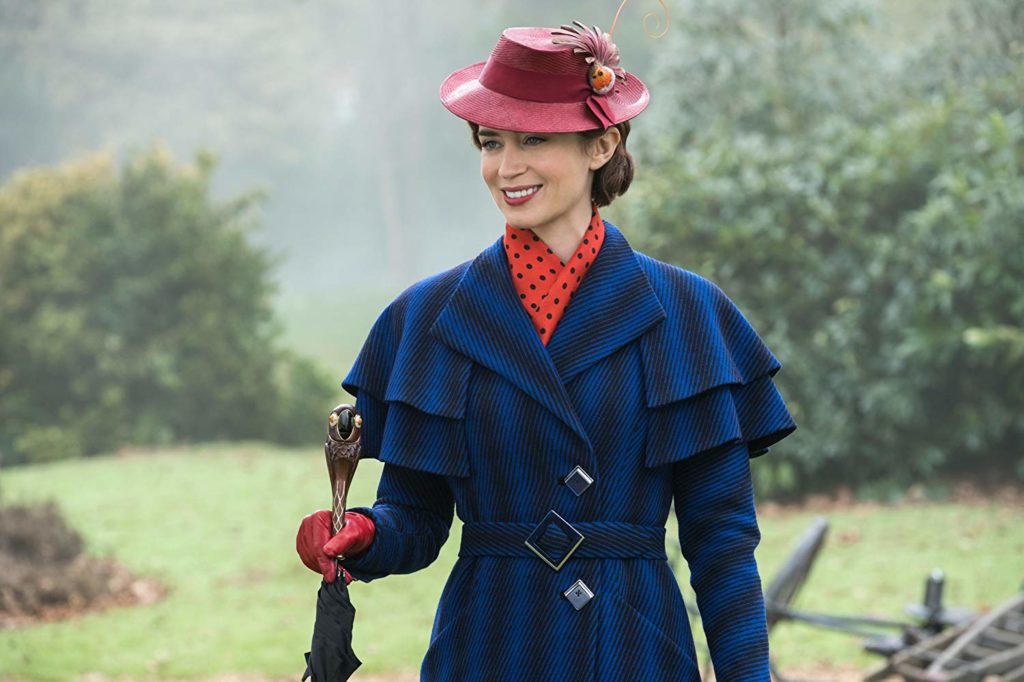
And again, the hand-drawn 2D animation sequence of “Royal Doulton Hall” melded with live action is perfection. 137 different animated characters and all done with the same style and integrity of that from 1964, and all just as eye-popping and enjoyable.

You definitely won’t need a spoonful of sugar to watch MARY POPPINS RETURNS. The minute you see that umbrella in the sky, it’s as if she never left Number 17 Cherry Tree Lane and the hearts and minds of millions around the world. Get ready to “Trip A Little Light Fantastic” with MARY POPPINS RETURNS!
Directed by Rob Marshall
Written by David Magee with story by Magee, Marshall and Jon DeLuca based on the “Mary Poppins” stories by P.L. Travers
Cast: Emily Blunt, Lin-Manuel Miranda, Dick Van Dyke, Emily Mortimer, Ben Whishaw, Colin Firth, Meryl Streep, Angela Lansbury
by debbie elias, 11/27/2018












